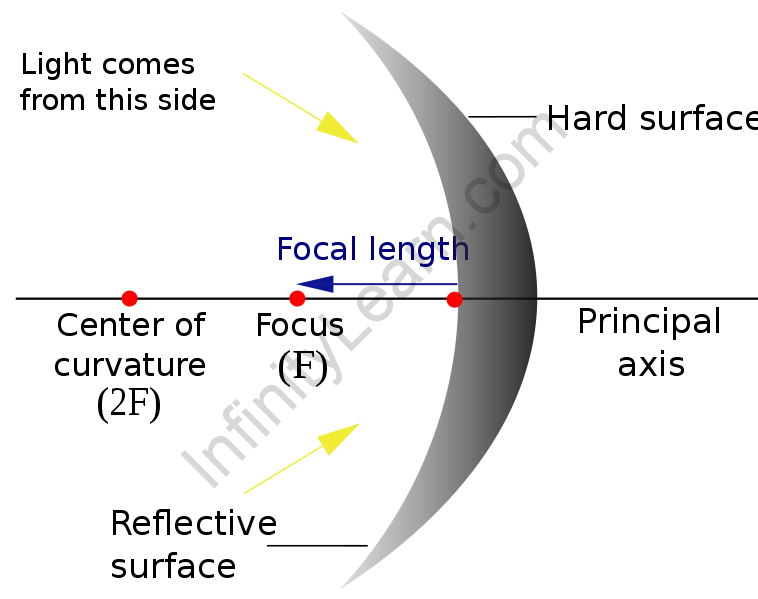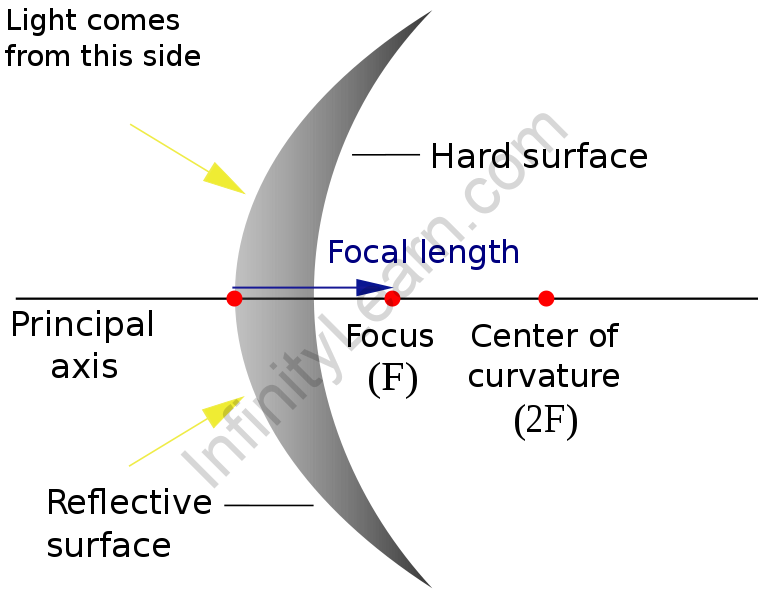Table of Contents
Introduction:
Spherical mirrors: A round reflection is one that is cut from a circular surface and has the state of a piece cut out of it. Sunken and curved round mirrors are the two kinds of circular mirrors. Shaving mirrors and restorative mirrors are two of the most common kinds of sunken mirrors. These mirrors, as is commonly known, amplify objects that are put near them. The traveler side wing reflections of vehicles are the most widely recognized instances of raised mirrors. Albeit these mirrors have bigger fields of view than indistinguishable level mirrors, the articles that show up in them seem more modest (and henceforth farther away) than they are.
A brief outline
Terminologies
When studying spherical mirrors, there are a few key terms that must be understood:
Curvature’s Center
The point in the mirror’s center crosses through its curve and has the same tangent and curvature as the curve.
Curvature Radius
It’s the distance between both the pole and the center of curvature in linear terms.
Axis principal
Any lens or spherical mirror has an imaginary line traveling through the optical centre and the centre of curvature.
Pole
The spherical mirror’s midway.
Aperture
An aperture in a mirror or lens is the point at which light is actually reflected. It also specifies the mirror’s size.
The principal focus
Focal Point is another name for Principal Focus. After reflection or refraction, rays of light parallel to the axis converged or appear to converge on the axis of a mirror or lens.
Focus
After being reflected from the mirror, light rays aligned to the primary axis will converge at any given position.
Important concepts
Mirror with Concavity
A spherical mirror is a cut out of a reflective sphere, as we all know. A concave mirror does have the reflected surface curled inwards on one edge. Concave mirrors are frequently used as shaving mirrors, dental mirrors, and even telescopes. The magnified reflected picture has a limited field of view. Converging mirrors are sometimes known as concave mirrors.
Mirror with Convex Surface
A convex mirror, on the other hand, has a reflective surface that curves outwards. Convex mirrors are often utilized in automobile mirrors. The reflected image shrinks in size as the focal length increases, while the field of view expands. For drivers, this is extremely beneficial because blind zones are greatly decreased. Convex mirrors are sometimes known as diverging mirrors or fish eye mirrors. These mirrors are easily identified by their outward bulge, which is visible the majority of the time.
Mirror Formula Derivation
A pole is a location in a mirror where the reflecting surface’s centre is located. It is denoted by the letter P. The radius of the curvature will be called the radius of the curvature, and the centre of the curvature will be called the centre of the curvature. The primary axis is the line that connects the pole to the curvature’s centre. The focus point is the midpoint of the line segment connecting the pole P and the centre of curvature C. The letter F stands for it.
f = focal length.
a = The distance between the object and the mirror’s pole.
b = The distance between the mirror and the picture it creates.
Before deriving the equation, it’s important to grasp a few patterns:
- The “P” pole is the starting point for all distance measurements.
- Distances measured in the direction of light incidence are positive, whereas those measured in the opposite direction are negative.
- The height can be used to determine positive and negative points; if they are higher than the principal axis, they are positive; if they are lower than the principal axis, they are negative.
- The ray diagram can be used to calculate the distance between the positive and negative picture.
It is highly recommended that you study with diagrams because the notion of mirrors is easier to grasp with graphics than just text. This is due to the fact that visuals imbue the mind with a concept more quickly than text does. Students can learn about spherical mirrors more easily by visiting Vedantu’s official website, which has simple and flashy content to assist them to study better. The content is available in PDF format, which is free to download.
The Sun, as the sole parallel beams of light impinging on the mirror, is an example of a concave mirror, and the rays from the Sun can be regarded almost parallel. The Sun, because it is a sphere, emits light radially outwardly; that is, light rays move outwards along the radius, yet we know that the Sun is a long way from the earth. As a result, the Sun’s beams approaching the earth’s surface are parallel, indicating that our object, the Sun, is at infinity and releasing parallel rays of light.


Convex Mirror’s ApplicationsRearview mirror:
With the help of convex mirrors, the car’s side-view mirror creates a compact and erect picture that allows the driver to see behind the vehicle. Security mirrors in ATMs: Security mirrors are placed near ATMs so that bank customers may inspect whether or not someone is standing behind them. Concave Mirror’s Applications Satellite Dishes with Concave Mirrors: Satellite dishes are one of the most common applications for concave mirrors. These are used to receive and enhance the weaker signals supplied by communication satellites. These impulses are reflected back in parallel rays by the concave mirror. These reflected beams condense at the mirror’s focal point. The primary goal of this mirror is to collect weaker signals from a wide area and concentrate them into a single point. A powerful source of light is kept in a smaller space at the back of the headlamp at the focus point of the concave mirror. Any light striking the concave mirror from the focus will be reflected parallel to its axis. A shaving mirror is another application for a concave mirror. People can use the picture generated by the concave mirrors’ reflections to help them shave. Concave dentist’s mirror: The concave mirrors assist the dentist in focusing light on the tooth being checked.
Significance of spherical mirrors in NEET exam
Optics is a crucial chapter for the NEET test as well as future reference and competitive exam preparation. There are a few key points in the Chapter that you cannot afford to overlook. Some of the chapter’s key topics are light reflection, spherical mirrors, and light refraction. In board exams, questions from this chapter contain numerical and definitional problems.
You may obtain significant test questions on Infinity Learn‘s website, which will help you understand the types of problems that are commonly asked in board examination for class 12 Physics Chapter ray optics.
Also read: Reflection of Light
FAQs
What are the greatest resources for learning about spherical mirrors?
The simplest way to grasp the concept of spherical mirrors is to gain a basic understanding of the physics that underpins them. A sphere is used to make spherical mirrors, which are curved objects. The students' knowledge of concave and convex curved surfaces, as well as their applications and types, is determined by their understanding of them. Vedantu contains detailed notes on spherical mirrors, their applications, properties, and derivations that students need to comprehend spherical mirrors and related subtopics.
What are all the distinctions between concave and convex mirrors?
Spherical mirrors are those with a curved reflecting surface that is shaped like a sphere. Spherical mirrors can be classified into two types: concave mirrors with an inwardly curved reflecting surface and convex mirrors with an outwardly curved reflecting surface. A concave mirror is more than simply a midway; it's also the point at which all parallel light beams, as well as those parallel to the primary axis, converge after reflection.
What are the key terms to remember when it comes to spherical mirrors?
The hollow sphere of glass whereby the mirror is a portion is known as the centre of curvature. The pole serves as the spherical mirror's focal point. The straight path or line that passes through curvature and the pole is the main axis. The mirror's aperture is the part of the mirror where light is reflected. All of the light rays converge on the primary axis, which is where the focal point is located, after reflection. The distance between the pole and the main focus is known as focal length.







